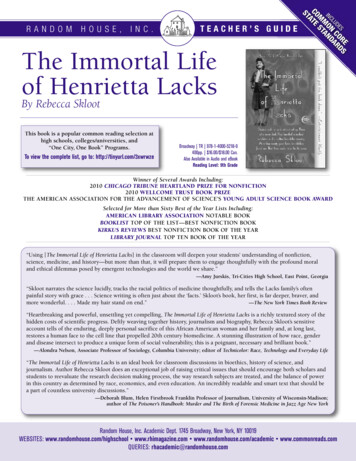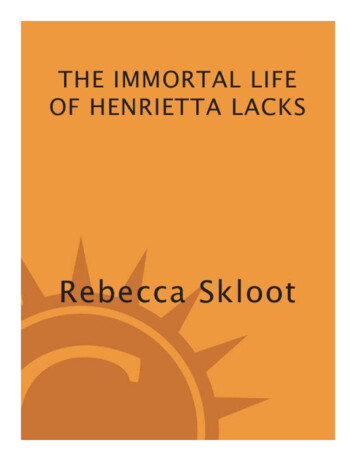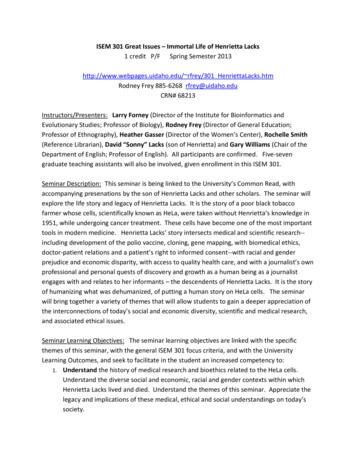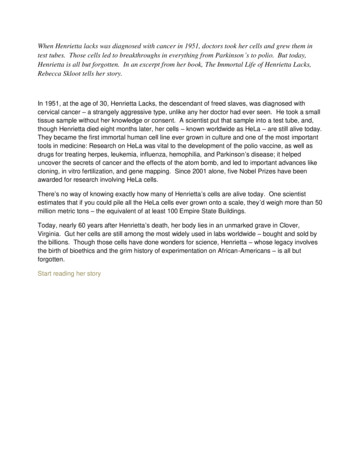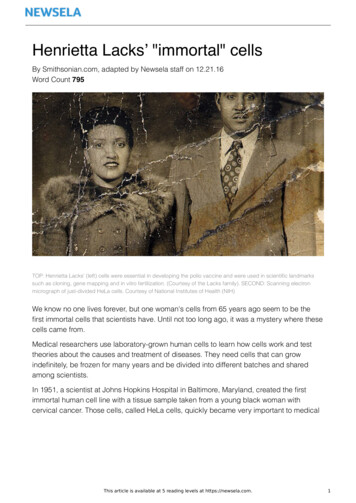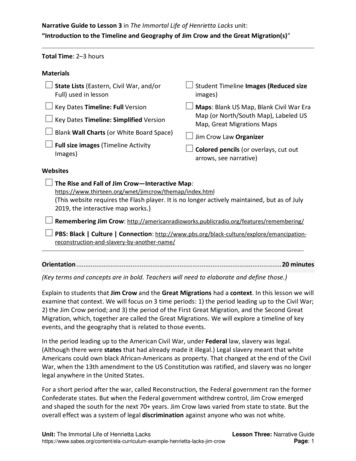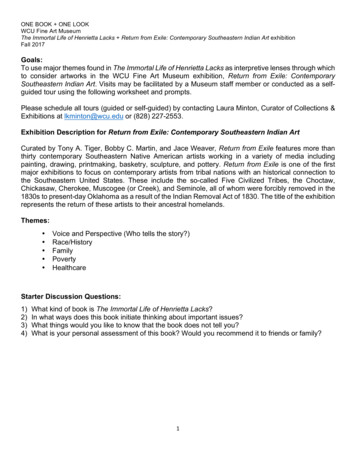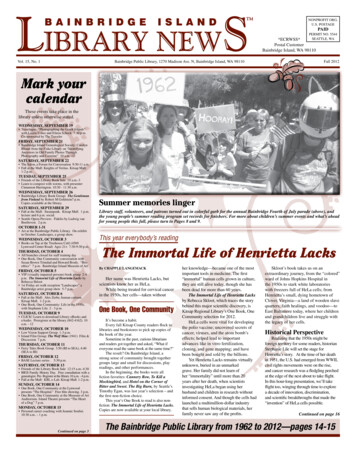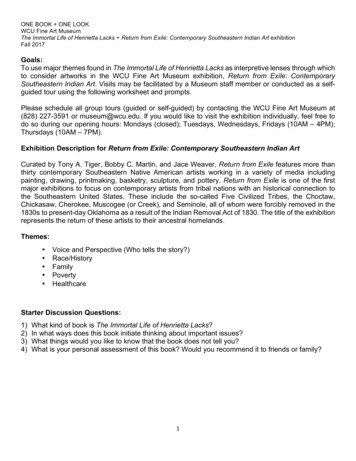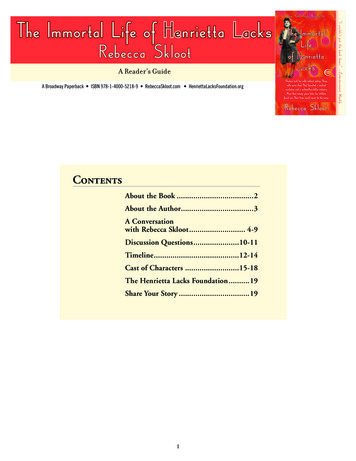
Transcription
The Immortal Life of Henrietta LacksRebecca SklootA Reader’s GuideA Broadway Paperback ISBN 978-1-4000-5218-9 RebeccaSkloot.com HenriettaLacksFoundation.orgContentsAbout the Book.2About the Author.3A Conversationwith Rebecca Skloot. 4-9Discussion Questions.10-11Timeline.12-14Cast of Characters.15-18The Henrietta Lacks Foundation.19Share Your Story.191
The Immortal Life of Henrietta LacksRebecca SklootA Reader’s GuideA Broadway Paperback ISBN 978-1-4000-5218-9 RebeccaSkloot.com HenriettaLacksFoundation.orgAbout the BookIn 1950, Henrietta Lacks, a young mother of five children, entered the colored ward of The Johns HopkinsHospital to begin treatment for an extremely aggressive strain of cervical cancer. As she lay on the operatingtable, a sample of her cancerous cervical tissue was taken without her knowledge or consent and given toDr. George Gey, the head of tissue research. Gey was conducting experiments in an attempt to create animmortal line of human cells that could be used in medical research. Those cells, he hoped, would allowscientists to unlock the mysteries of cancer, and eventually lead to a cure for the disease. Until this point,all of Gey’s attempts to grow a human cell line had ended in failure, but Henrietta’s cells were different:they never died.Less than a year after her initial diagnosis, Henrietta succumbed to the ravages of cancer and was buried inan unmarked grave on her family’s land. She was just thirty-one years old. Her family had no idea that partof her was still alive, growing vigorously in laboratories—first at Johns Hopkins, and eventually all over theworld.Thirty-seven years after Henrietta’s death, sixteen-year-old Rebecca Skloot was a high school student sittingin a biology class when her instructor mentioned that HeLa, the first immortal human cell line ever grownin culture, had been taken from an African American woman named Henrietta Lacks. His casual remarksparked Skloot’s interest, and led to a research project that would take over a decade to complete. Herinvestigation of the true story behind HeLa eventually led her to form significant––and in some cases, lifechanging––relationships with the surviving members of the Lacks family, especially Henrietta’sdaughter, Deborah.In telling Henrietta’s story, Skloot draws from primary sources and personal interviews to provideinsightful narrative accounts of Henrietta’s childhood, young adulthood, diagnosis, illness, and tragic death.She also explores the birth and life of the immortal cell line HeLa, and shows how research involving HeLahas changed the landscape of medical research, leading to not only scientific and medical breakthroughs, butalso new and evolving policies concerning the rights of patients and research subjects.As the story of HeLa unfolds, so does the story of Henrietta’s surviving children, who for two decades wereunaware of the existence of their mother’s cells—and the multimillion-dollar industry that developed aroundthe production and use of HeLa. Central to this narrative is the relationship between Skloot and Deborah.As Skloot tenaciously worked to gain Deborah’s trust, Deborah struggled to understand what had happenedto her mother and her mother’s cells. The result of their relationship is an illuminating portrait of theenduring legacy of Henrietta’s life, death, and immortality.2
The Immortal Life of Henrietta LacksRebecca SklootA Reader’s GuideA Broadway Paperback ISBN 978-1-4000-5218-9 RebeccaSkloot.com HenriettaLacksFoundation.orgAbout the AuthorREBECCA SKLOOT is an award-winning science writer whose articles have appeared in The New YorkTimes Magazine; O, The Oprah Magazine; Discover; Prevention; Glamour; and others. She has worked as acorrespondent for NPR’s Radiolab and PBS’s NOVA scienceNOW, and is a contributing editor at PopularScience magazine and guest editor of The Best American Science Writing 2011. Her work has been anthologizedin several collections, including The Best Creative Nonfiction. She is a former vice president of the NationalBook Critics Circle, and has taught creative nonfiction and science journalism at the University of Memphis,the University of Pittsburgh, and New York University. She lives in Chicago. The Immortal Life of HenriettaLacks is her first book. It is being translated into more than twenty languages and adapted into an HBOfilm produced by Oprah Winfrey and Alan Ball. She is the Founder and President of the Henrietta LacksFoundation. For more information, visit her website at RebeccaSkloot.com, where you’ll find links to followher on Twitter and Facebook.3
The Immortal Life of Henrietta LacksRebecca SklootA Reader’s GuideA Broadway Paperback ISBN 978-1-4000-5218-9 RebeccaSkloot.com HenriettaLacksFoundation.orgA Conversation with Rebecca SklootWas it wrong for the scientists to have taken Henrietta’s cells?In the 1950s when Henrietta’s cells grew, the concept of informed consent that we have today didn’t exist. People wereroutinely used in research without their knowledge. Scientists knew very little about the basic functioning of cells—theycouldn’t have imagined that someday those cells would be valuable, that someday researchers could look inside them atHenrietta’s DNA and learn things about her and her children and grandchildren. It was a completely different mindset thanthe one we have now, but it was not ill-intended, or unethical by the standards of the day. George Gey, the scientist who firstgrew the cells, was devoted to curing cancer. He took cells from himself and his own kids. He never sold the HeLa cells, henever tried to patent them or anything else, including equipment he invented that’s still used around the world that couldhave made him large amounts of money. Gey was pretty impoverished, but he spent his own money in the lab. Taking cellsfrom patients was absolutely standard practice worldwide in the ’50s. In a lot of ways, it still is today.Why didn’t Henrietta’s cells die like all the other cells before them?That’s still a bit of a mystery. Scientists know that Henrietta’s cervical cancer was caused by HPV, and her cells have multiplecopies of the HPV genome in them, so some researchers wonder if the multiple copies of HPV combined with somethingin Henrietta’s DNA caused her cells to grow the way they did. Henrietta also had syphilis, which can suppress the immunesystem and cause cancer cells to grow more aggressively. But many people had HPV and syphilis (particularly in the ’50s)and their cells didn’t grow like Henrietta’s. I’ve talked to countless scientists about HeLa, and none could explain whyHenrietta’s cells grew so powerfully when others didn’t. Today there are other immortal cell lines, and it’s possible forscientists to immortalize cells by exposing them to certain viruses or chemicals; but there still hasn’t been another cell linelike HeLa, which grows in a very unique way.If HeLa cells are cancer cells, how are they useful for research into anything other than cancer,like vaccine production?Since the ’50s, if researchers wanted to figure out how cells behaved in a certain environment, or reacted to a specificchemical, or produced a certain protein, they turned to HeLa cells. They did that because, despite being cancerous, HeLastill shared many basic characteristics with normal cells: They produced proteins and communicated with one another likenormal cells, they divided and generated energy, they expressed genes and regulated them, and they were susceptible toinfections, which made them an optimal tool for synthesizing and studying any number of things in culture, includingbacteria, hormones, proteins, and especially viruses.Viruses reproduce by injecting bits of their genetic material into a living cell, essentially reprogramming the cell so itreproduces the virus instead of itself. When it came to growing viruses—as with many other things—the fact that HeLawas malignant just made it more useful. HeLa cells grew much faster than normal cells, and therefore produced resultsfaster. HeLa is a workhorse: It’s hardy, it’s inexpensive, and it’s everywhere. Today, it’s even possible for scientists togenetically alter HeLa cells to make them behave like other cells—a heart cell, for example. So being cancer cells isn’tthe limitation most expect that it would be, though there are some things you definitely wouldn’t use HeLa cells for,including any vaccine creation, since you wouldn’t want to inject cancer cells along with a vaccine.4
The Immortal Life of Henrietta LacksRebecca SklootA Reader’s GuideA Broadway Paperback ISBN 978-1-4000-5218-9 RebeccaSkloot.com HenriettaLacksFoundation.orgWhy was the existence of the HeLa cells so difficult for Henrietta’s family?The story of the HeLa cells isn’t just about cells being taken from a woman without consent. There’s much more to it: Noone told her family that the cells existed until the ’70s, when scientists wanted to do research on her children to learn moreabout the cells. Her children were then used in research without their consent, and without having their most basic questions about the cells answered (questions like “What is a cell?” and “What does it mean that Henrietta’s cells are alive?”).This was very frightening, particularly for Henrietta’s daughter, Deborah. The science all had a very scary sci-fi quality toit, so she had a very hard time distinguishing what was reality and what wasn’t when it came to science. She worried thatthere were clones of her mother walking around that she might bump into. And she worried that what the researchscientists were doing to her mother’s cells somehow caused her mother pain in the afterlife. She’d say, “If scientists areshooting my mother’s cells to the moon and injecting them with chemicals, can she rest in peace?” For her, theseexistential questions were really difficult. Other things that the family found upsetting: At one point, Henrietta’smedical records were released to a reporter and published without her family’s permission, which was very traumatizingfor her children. Henrietta’s sons were particularly very angry when they learned that people were buying and sellingHenrietta’s cells, which helped launch a multibillion-dollar industry, yet her family had no money. To this day, theycan’t afford health insurance.Why is the story of Henrietta Lacks important?It’s important for a lot of reasons, but perhaps the most central one is that we’re at a time when medical research relies moreand more on biological samples like Henrietta’s cells. A lot of the ethical questions raised by Henrietta’s story still haven’tbeen addressed today: Should people have a right to control what’s done with their tissues once they’re removed from theirbodies? And who, if anyone, should profit from those tissues? Henrietta’s story is unusual in that her identity was eventuallyattached to her cells, so we know who she was. But there are human beings behind each of the billions of samples currentlystored in tissue banks and research labs around the world. The majority of Americans have tissues on file being used inresearch somewhere, and most don’t realize it. Those samples come from routine medical procedures, fetal genetic-diseasescreening, circumcisions, and much more, and they’re very important for science—we rely on them for our most importantmedical advances. No one wants that research to stop, but it’s pretty clear that many people want to know when their tissuesare being used in research and when there’s a potential for them to be commercialized. The story of Henrietta, her family,and the scientists involved put human faces on all of those issues, which can be pretty abstract otherwise.What sparked your curiosity about the woman behind the HeLa cellsand made you devote more than ten years of your life to writing this book?The prologue of the book tells the story of how I learned about Henrietta’s cells for the first time when I was sixteen, but itdoesn’t really go into why that story grabbed me to the extent that it did. I think that’s because it wasn’t until after the bookwas published that I began to understand why the story had such an impact on me. When I first learned about Henrietta’scells in Mr. Defler’s biology class, the first questions I asked him were whether she had any children, what they thoughtabout Henrietta’s cells living on all these years after her death, and what did the fact that she was black have to do with it all.5
The Immortal Life of Henrietta LacksRebecca SklootA Reader’s GuideA Broadway Paperback ISBN 978-1-4000-5218-9 RebeccaSkloot.com HenriettaLacksFoundation.orgI realize now that my questions weren’t obvious ones for a sixteen-year-old to ask, but something was happening in my lifethat I think primed me to ask questions about the cells. That same year, my father had gotten sick with a mysterious illness noone was able to diagnose. He’d gone from being my very active and athletic dad to being a man who had problems thinking,and he spent all of his time lying in our living room because he couldn’t walk. It turned out that a virus had caused braindamage, and he eventually enrolled in an experimental drug study. Since he couldn’t operate a car, I drove him to and fromthe hospital several times a week and sat with him and many other patients as they got experimental treatments. So I was inthe midst of watching my own father go through research and was experiencing the hopes that can come with science, butalso the frustration and fear. It was a frightening time; the research didn’t help him, and in the end the study was dissolvedwithout fulfilling promises it made to the patients about access to treatment. The experience really taught me about thewonder and hope of science, but also the complicated and sometimes painful ways it can affect people’s lives.I was in the middle of that experience when my teacher mentioned that Henrietta’s cells had been growing in labs decadesafter her death. So I think I asked the questions I did because I was a kid wrestling with watching my own father be aresearch subject.How has the Lacks family reacted to your book?Henrietta’s children and grandchildren read THE IMMORTAL LIFE OF HENRIETTA LACKS before it came out as partof the fact-checking process. They were very happy with it—they didn’t object to any information in it or ask me to removeor change anything, other than pointing out some dates or other factual things that needed fixing. Naturally some of thebook was painful for Henrietta’s children to read, but it was also good for them to read about all of the amazing science thatHenrietta’s cells contributed to, which they feel very proud of. For the younger generations of Lackses, it was a way to learnabout their history: Their family didn’t really talk about what happened to Henrietta or her children. So the youngergeneration didn’t know much (if anything) about Henrietta or the cells. They didn’t know what Henrietta had contributedto science, they didn’t know what had happened to their own parents. So finally having the full story has helped make senseof their history—they’re also filled with pride about all that Henrietta’s cells have done for science.The Lacks family came to a lot of my public events when the book came out—they’d stand up in a room to answerquestions, and the crowd would cheer and give them standing ovations. Scientists often stood up saying, “Here’s whatI did with your mother’s cells, and thank you, I’m sorry that this has been hard for you and that no one told you whatwas going on.” Scientists and general readers would stand in long lines waiting for their autographs. The enormous publicresponse to the book has been great for the family—I think there’s been some healing through that process for them.How has the Lacks family benefited from your book?The family has benefited from the book in several different ways, including the closure and thanks from scientists that Imentioned earlier. When it came to money, I didn’t want to be another person who came along and potentially benefitedfrom the family and their story without doing something in return. So I set up The Henrietta Lacks Foundation and am6
The Immortal Life of Henrietta LacksRebecca SklootA Reader’s GuideA Broadway Paperback ISBN 978-1-4000-5218-9 RebeccaSkloot.com HenriettaLacksFoundation.orgdonating a portion of the book’s proceeds to it. The foundation has been in existence since January 2010, and anyone candonate via the foundation’s website (HenriettaLacksFoundation.org). So far donations have come in steadily, ranging from 1 to about 500, with the average being in the 50– 100 range. These donations are from the general reading public andindividual scientists who feel that they have benefited from HeLa cells in some way and want to do something in return forthe family.Among other things, the foundation provides scholarship funds for descendants of Henrietta Lacks, so they can getthe education that Henrietta and her family didn’t have access to but desperately wanted. It also aims to help providehealth-care coverage for Henrietta’s children. So far the foundation has been able to pay full tuition and books for eight ofHenrietta Lacks’s grandchildren and great-grandchildren who are now working toward undergraduate, graduate, and tradedegrees. It has also provided money for medical assistance for Henrietta’s children and grandchildren. The Henrietta LacksFoundation strives to provide financial assistance to needy individuals who have made important contributions to scientificresearch without personally benefiting from those contributions, particularly those used in research without their knowledgeor consent.People often ask if any of the companies or research institutions that have sold or benefited from HeLa cells have given thefamily any money. The answer is they haven’t, and likely never will. There is concern among research organizations that giving money to the Lacks family would set a legal precedent: If they pay Henrietta’s family for use of HeLa cells, what aboutthe millions of other people whose cells and tissues have been used in research? Who pays them, and how much? One of myhopes in setting up the foundation was that some of those companies and research institutions might feel that donating toa foundation in Henrietta’s name would let them recognize her contribution to science and the impact it had on her family,without concern for setting a legal precedent. So far that hasn’t happened.Is the Lacks family still angry about HeLa cells?The Lacks family has gotten to a point where they try to separate what happened with Henrietta’s cells from what happenedto them. Henrietta’s cells have been this incredible thing for science and her family really sees that as a miracle, and they’vegotten to a point now where they can look at them and say, “We think that they’re incredible, and they’ve done wonderfulthings—and that makes us happy. We’re very glad that her cells are out there and being used in the way that they are. Wewish it didn’t happen the way that it did. We wish they’d told us. We wish they’d asked, because we would have said yes. Wewish they’d explained things to us when we asked. We wish they hadn’t released her medical records.” There were a lot ofthings they were unhappy about in terms of the way that they were treated, but the way they think about the cells definitelydoes not reflect a feeling of her being enslaved. It’s more of her being an angel. In life Henrietta was this woman who livedto take care of everybody, and so to the family it makes perfect sense that she’s doing that in death, too. They don’t see thecells themselves as a dark or negative thing.That said, they are still quite upset about the issue of money, and the fact that others have profited from the cells and herfamily hasn’t, which is still the case today. The Lacks family is still hoping that Hopkins and the many companies that haveprofited off of HeLa cells will do something to honor Henrietta and recognize what her family went through.7
The Immortal Life of Henrietta LacksRebecca SklootA Reader’s GuideA Broadway Paperback ISBN 978-1-4000-5218-9 RebeccaSkloot.com HenriettaLacksFoundation.orgWhat messages should be taken from this story?Some of that depends on each individual reader, because there are a lot of potential messages from the book: It’s abouttrust, race and medicine, class, access to education and health care; it’s also the story of a family and the impact that losing amother can have on her children, and much more.It’s also about the fact that there are people behind every one of the billions of biological samples that are used in researchevery day. I can’t count the number of emails I’ve gotten from researchers who say that they heard me talking on the radio orread the book and had this very powerful reaction of saying, “Oh wow, I had no idea. I did my dissertation on HeLa cells. Iwork with them every day in my lab—I owe a lot of my career to Henrietta’s cells, and I never once stopped to think aboutwhere they came from, whether she had given consent, or whether her family might care about that.” These are questionsthat scientists don’t often think about. I also hear researchers saying that after learning the story of the HeLa cells, they nolonger complain about the regulation of science and the mountains of forms they have to fill out for every study they wantto do. In the book, you find out the history behind those forms, why they’re now required, and why it is important. Thoseare important take-home messages.But this is also a story about the fact that there are human beings behind every scientist as well. The scientists in the HeLastory have long been demonized in ways that weren’t factually accurate, so I hoped to set that record straight.What role did race play in Henrietta’s and her children’s experiences?This is the story of how cells taken from a black woman without her knowledge became one of the most important advancesin medicine and launched a multibillion-dollar industry, with drastic consequences for her family. It’s inextricably linked tothe troubling history of research conducted on African Americans without their consent, and many people—particularlyAfrican Americans—are hungry to learn Henrietta’s story and how it fits into that history.For decades, the story of Henrietta Lacks and the HeLa cells has been held up as “another Tuskegee,” the story of a racistwhite scientist who realized a black woman’s cells were valuable, stole them from her, then got rich selling them—perhapseven withholding treatment for her cancer in order to be sure the cells would grow. But none of that is true. Henrietta gotthe standard cervical cancer treatment for the day, and no one knew her cells would be valuable. George Gey gave themaway for free and never profited directly from them (they were later commercialized by others). In 1951 when Henriettashowed up at Hopkins, taking tissues from patients without consent had been standard practice for decades. Henrietta’ssample was taken as part of a study on cervical cancer for which researchers were taking samples from any woman whowalked into Hopkins with cervical cancer, regardless of race. Henrietta wasn’t targeted because her cells were known to bevaluable, or because they were trying to grow cells from a black person. Gey didn’t even know she was black until after thecells grew.8
The Immortal Life of Henrietta LacksRebecca SklootA Reader’s GuideA Broadway Paperback ISBN 978-1-4000-5218-9 RebeccaSkloot.com HenriettaLacksFoundation.orgThat said, race did play an important role in the story: During the Jim Crow era, Hopkins was a segregated charityhospital—patients in the “public” ward where Henrietta was treated were there because they were either black or poor(often both). They couldn’t get treated elsewhere. And the prevailing attitude at the time was that since “charity cases” weretreated for free, doctors were entitled to use them in research, whether the patients realized it or not. Henrietta’s doctor oncewrote, “Hopkins, with its large indigent black population, had no dearth of clinical material.” That attitude was widespreadat the time.But this story is just as much about issues of class and economic injustice. Many people have asked me, “Would those cellshave been taken from her if she’d been white?” The answer is yes, if she’d been white and poor. Many of the difficulties Henrietta’s family faced came down to issues of class: their lack of access to education, their inability to afford health care despitethe fact that their mother’s cells helped lead to so many important medical advances. The Lacks family often says,“If our mother was so important to medicine, why can’t we get health insurance?” That question gets at the heart of whatmany readers find most upsetting about the Lacks family’s story.How does this story relate to today’s health-care debate?When you have a biopsy taken at a hospital you sign a form that says your doctor can dispose of your tissues any way hesees fit or strip them of your identity and use them in research. The attitude has long been that everyone should allow theirtissues to be used for the good of science, since the research can lead to medical progress—important drugs, vaccines, etc.—from which everyone benefits. But the thing is, not everyone does benefit in the United States, because we don’t have universal access to health care. There is an imbalance in this country, which means many of the medical advances coming fromtissue research aren’t available to everyone, sometimes including those who provided raw materials for the research. That’s apretty stark point in the health-care debate.From your afterword on tissue banking and cell culture laws, it really sounds like the same thing could happentoday but without the name attached to it. Has anything changed on that front since the book was published?No, nothing has formally changed in terms of the regulation of tissue research, but there is certainly much more publicawareness of the fact that research happens on tissues without consent; and there’s a public discussion happening about thison a much larger scale than has happened before. There also does seem to be a shift happening in the way questions abouttissue-research ethics are being handled.In the afterword of the book, I wrote about several related court cases that were pending; several of them have since beenruled on in ways that indicate the courts are leaning toward requiring consent. But as of the publication of the paperbackedition of THE IMMORTAL LIFE OF HENRIETTA LACKS, there have been no changes in the laws governing tissueresearch; so as of today there is still no requirement for consent for most tissue research, and the law as I laid it out in thebook’s original afterword is still in place.9
The Immortal Life of Henrietta LacksRebecca SklootA Reader’s GuideA Broadway Paperback ISBN 978-1-4000-5218-9 RebeccaSkloot.com HenriettaLacksFoundation.orgDiscussion Questions1. O n page xiii, Rebecca Skloot states, “This is a work of nonfiction. No names have been changed, no characters invented, noevents fabricated.” Consider the process Skloot went through to verify dialogue, re-create scenes, and establish facts. Imaginetrying to re-create scenes such as when Henrietta discovered her tumor (page 15). What does Skloot say on pages xiii–xivand in the notes section (page 346) about how she did this?2. O ne of Henrietta’s relatives said to Skloot, “If you pretty up how people spoke and change the things they said, that’s dishonest” (page xiii). Throughout, Skloot is true to the dialect in which people spoke to her: The Lackses speak in a heavySouthern accent, and Lengauer and Hsu speak as nonnative English speakers. What impact did the decision to maintainspeech authenticity have on the story?3. As much as this book is about Henrietta Lacks, it is also about Deborah learning of the mother she barely knew, while alsofinding out the truth about her sister, Elsie. Imagine discovering similar information about one of your family members.How would you react? What questions would you ask?4. I n a review for the New York Times, Dwight Garner writes, “Ms. Skloot is a memorable character herself. She never intrudeson the narrative, but she takes us along with her on her reporting.” How would the story have been different if she had notbeen a part of it? What do you think would have happened to scenes like the faith healing on page 289? Are there otherscenes you can think of where her presence made a difference? Why do you think she decided to include herself in the story?5. D eborah shares her mother’s medical records with Skloot but is adamant that she not copy everything. On page 284 Deborah says, “Everybody in the world got her cells, only thing we got of our mother is just them records and her Bible.” Discussthe deeper meaning behind this statement. Think not only of her words, but also of the physical reaction she was having todelving into her mother’s and sister’s medical histories. If you were in Deborah’s situation, how would you react to someonewanting to look into your mother’s medical records?6. T his is a story with many layers. Though it’s not told chronologically, it is divided into three sections. Discuss the significance of the titles given to each part: Life, Death, and Immortality. How would the story have been different if it were toldchronologically?7. As a journalist, Skloot is careful to present the encounter between the Lacks family and the world of medicine withouttaking sides. Since readers bring their own experiences and opinions to the text, some may feel she took the scientists’ side,whil
The Immortal Life of Henrietta Lacks Rebecca Skloot A Broadway Paperback ISBN 978-1-4000-5218-9 RebeccaSkloot.com HenriettaLacksFoundation.org A Reader's Guide 3 About the Author REBECCA SKLOOT is an award-winning science writer whose articles have appeared in The New York


